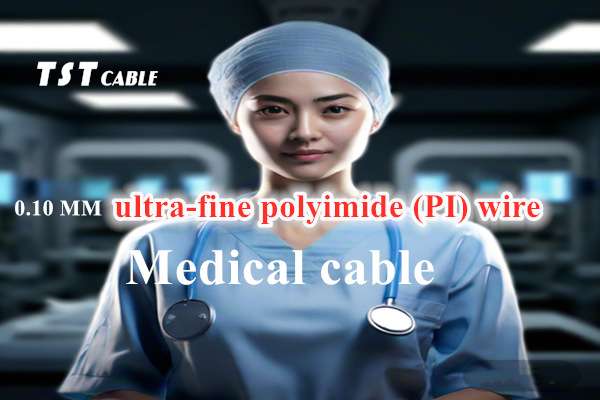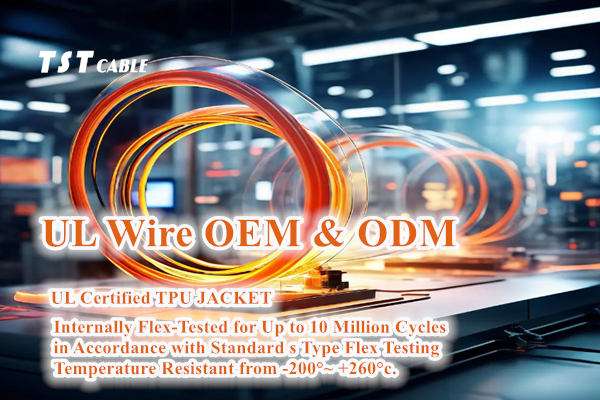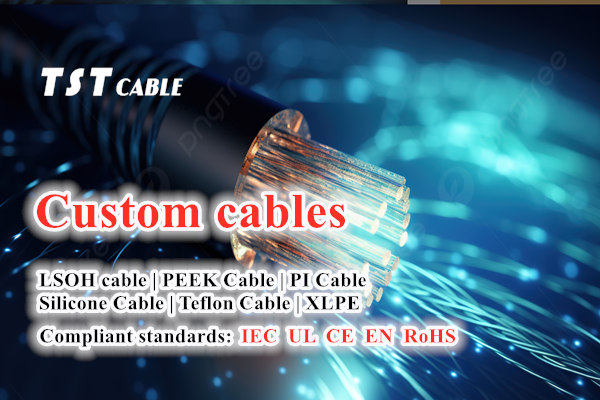TPU Cable Material

TPU cable (Thermoplastic Polyurethane) is an elastomeric cable with unique properties, which combines the elasticity of rubber and the processing properties of plastic. TPU cable has been widely used in many industries due to its excellent physical and chemical properties.
TPU cable is based on advanced formula and process technology. In addition to the traditional performance characteristics of TPU material, RYD series TPU cable material overcomes its weakness of poor processing and shows unique processing properties: easy extrusion, less particles, no eye mold residue and other characteristics.
Introduction to TPU Material
TPU is a linear block copolymer composed of alternating hard segments (usually polyurethane segments) and soft segments (usually polyether or polyester segments). This structure gives TPU material a unique combination of properties, making it perform well in a variety of applications.
Properties of TPU plastic
High elasticity: TPU has high elasticity and recovery ability, and can quickly return to its original shape even after repeated stretching.
Wear resistance: TPU has excellent wear resistance and is suitable for applications that need to withstand friction for a long time.
Oil and chemical resistance: TPU has good resistance to most oils, solvents and many chemicals.
Tear strength: TPU material has good tear resistance and is not easy to break under stress.
Transparency: Some types of TPU can be made into transparent materials, which are suitable for applications that require transparency.
Cold resistance: TPU can still maintain its flexibility and elasticity at low temperatures.
Biocompatibility: Some TPU varieties are biocompatible and can be used in medical devices and other fields.
Environmental protection: Compared with some traditional plastics, TPU produces less waste during the production process and is easy to recycle.
Advantages of TPU
Excellent mechanical properties: TPU has both hardness and softness, and its hardness can be adjusted as needed.
Convenient processing: TPU can be formed by a variety of processing methods such as injection molding and extrusion, which is suitable for large-scale production.
Good weather resistance: TPU has a certain resistance to ultraviolet rays and is not easy to age.
Environmental protection: TPU does not contain harmful substances such as plasticizers, which is friendly to the human body and the environment.
Disadvantages of TPU
High cost: Compared with ordinary plastics, the production cost of TPU is higher.
Insufficient heat resistance: TPU is not as heat resistant as some other plastic materials and is not suitable for long-term high temperature environments.
Susceptible to environmental influences: TPU is susceptible to microorganisms and ultraviolet rays in certain environments, leading to aging.
Processing temperature limit: TPU has a narrow processing temperature range, and excessively high temperatures may cause the material to decompose.
Uses of TPU
Shoe materials: midsole materials and insoles for sports shoes.
Clothing accessories: such as waterproof and breathable films, thermal insulation materials, etc.
Automotive parts: automotive interior parts, wires, sealing strips, bumpers, etc.
Medical devices: infusion tubes, catheters, surgical instruments, etc.
Electronic products: mobile phone cases, wires, keyboard membranes, screen protectors, etc.
Industrial products: seals, hoses, cable sheaths, etc.
Sports goods: golf club handles, skis, bicycle seats, etc.
Differences between TPE cable and TPU cable Performance comparison
Thermoplastic elastomer is a thermoplastic elastomer material with the characteristics of high strength, high elasticity, injection molding, wide application, environmental protection, non-toxic safety, and excellent colorability.
Thermoplastic polyurethane (Thermoplastic Urethane), called thermoplastic polyurethane elastomer in Chinese, is a type of TPE. TPU is a polymer material composed of diphenylmethane diisocyanate (MDI), toluene diisocyanate (TDI), polymer polyols and chain extenders.
The difference between TPE cable and TPU cable:
1. Difference in specific gravity:
TPE thermoplastic elastomer (0.89~1.3);
TPU thermoplastic polyurethane (1.0~1.4);
2. Difference in oil resistance
It is difficult for TPE cable to be oil-resistant, but it feels good, soft and smooth;
TPU cable has good oil resistance, strong hand friction, and poor smoothness.
3. Difference in temperature resistance:
TPE cable (-60℃~105℃);
TPU cable (-60℃~80℃);
4. Difference in resilience and wear resistance:
TPU has better resilience and wear resistance than TPE.
5. Difference in hardness range:
TPE cable thermoplastic elastomer (0~100A);
TPU cable thermoplastic polyurethane (35~90A, 50~80D), the most common hardness is 80~95A. TPU with a hardness of 50~80D is rarely used in practice. Hardness 35~75A TPU, high material cost. TPU is characterized by high strength and good performance. The main features are: wide hardness range, with the increase of hardness, its products still maintain good elasticity and wear resistance, high mechanical strength, outstanding cold resistance, good processing performance, oil resistance, water resistance, mold resistance, good recycling.
TPU cable development trend
Sustainable development
Bio-based TPU: With the increase of environmental awareness, the use of bio-based raw materials to produce TPU has gradually increased, and this type of TPU has reduced its dependence on fossil fuels.
Degradable TPU: Develop biodegradable TPU materials to reduce environmental pollution, especially in the field of disposable products.
Functionalization
Conductive TPU wire: By doping conductive materials, conductive TPU can be produced, which is suitable for occasions requiring electrostatic protection.
Antibacterial TPU wire: TPU with antibacterial agent added or treated with antibacterial technology is suitable for medical and sanitary products to prevent bacterial growth.
Intelligent
Shape memory TPU: This TPU can change its shape under certain conditions and then return to its original form. It is suitable for smart wearable devices, medical implants and other fields.
Self-healing TPU: By adding self-healing ingredients, TPU can heal itself after being damaged, extending its service life.
Research progress
Currently, scientific research institutions and enterprises are actively studying new formulas and production processes for TPU to improve its performance and broaden its application range. For example:
Nano-enhanced TPU: By adding nanoparticles to TPU, its mechanical properties and thermal stability can be improved.
3D printing TPU: Developing TPU materials suitable for 3D printing technology makes it easier to manufacture complex structures.
High-performance TPU composite cables: Compounding TPU with other high-performance materials (such as carbon fiber and graphene) to obtain materials with higher strength and better functionality.
Common models, characteristics and applications of TPU cables
•Consumer electronics wire materials Appliance Wiring Materials
| Classification and standardsmodelFeaturesPolyester type non-flame retardantU10-W85Matte, polyester type, 85A, for wire sheathPolyester type non-flame retardantU20-W85Matte, polycondensation type, 85A, for wire sheathPolyether type flame retardant FT-2UF12-285Semi-matte, 85A, UL1581 temperature resistance level 80℃, for wire sheathPolyester type flame retardant VW-1UF12-585Semi-matte, 85A, UL1581 temperature resistance level 80℃, for wire sheathUF12-M90Frosted, 90A, UL1581 temperature resistance level 80℃, for wire sheath |
•EV Charging Cable Materials
| Classification and standardsmodelFeaturesPolyether type EV cable sheathUF12-DM85Frosted surface, 85A, performance meets IEC62895, EN50620, GB/T33594 sheathUF12-D85Matte surface, 85A, performance meets IEC62893, EN50620, GB/T33594 sheath |
•Road Vehicle Cable Materials
| Classification and standardsmodelFeaturesPolyether EPB/ABSUF12-CM85Frosted surface, hardness 85A, performance meets IS0 6722C levelUF12-C90Matte surface, hardness 90A, performance meets IS0 6722C level |
•Optic Fiber Cable Materials
| Classification and standardsmodelFeaturesPolymer typeUF12-D92Hardness 92A, matte surface, flame retardant EC60532-1, used for optical cable sheath |
•Industrial Equipment Cable Materials
| Classification and standardsmodelFeaturesPolyether type UL temperature resistance rating 80℃UF12-D86Hardness 86A, flame retardant IEC60332-1, used for cable sheaths of robots, mining machinery, military equipment, etc.Polyether type UL temperature resistance rating 105℃UF12-P90Hardness 90A, hydrolysis resistant, flame retardant VW-1, used for cable sheaths of robots, mining machinery, military equipment, etc. |
•Medical Cable Materials
| Classification and standardsmodelFeaturesPolyacid type ISO 10995U20-80Hardness 80A, soft touch, 24-hour 100% extract cell viability> 75%, the product is safe and reliable |
•Irradiated Crosslinked TPU Cable Materials
| Classification and standardsmodelFeaturesIrradiation cross-linked polyXLPU12-90Hardness 90A, flame retardant in accordance with UL94 V-2, cross-linked to form a network structure, does not melt at high temperatures, shows excellent resistance to high temperature pressure and high temperature thermal extension, used for cutting high temperature sheath materials |
In addition to the above models, TST CABLES can also customize TPU /TPE cables of other specifications according to your actual needs. Welcome to email(lixiangchao@testeck.com) for consultation.
As a high-temperature special cable with elasticity, wear resistance and chemical stability, TST CABLES TPU cable has demonstrated its unique advantages in many fields. With the advancement of science and technology and the growth of market demand, the application scope of TST CABLES TPU will continue to expand and develop in a more environmentally friendly and functional direction. In the future, TST CABLES TPU cable will play an important role in more emerging fields and promote the innovative development of related industries.
Also available in:
English



